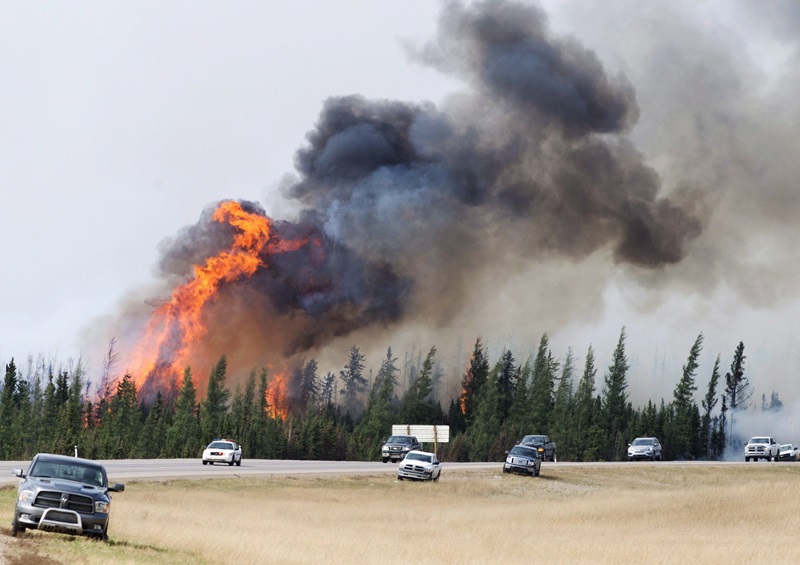90% of wildfire losses are preventable. How brokers can help.

About 90% of wildfire damage in B.C. is preventable, a FireSmart B.C. representative told the province’s brokers attending the Insurance Brokers Association of B.C. Thursday. Brokers can help reduce losses by showing clients how to prevent stray embers from setting homes and properties ablaze.
“There are two things I want you to remember through my presentation,” said Ryan Moreside, administrative coordinator of the home partners program of FireSmart B.C. “Wildfire losses are preventable, that’s the big one. We’re not at the mercy of a tsunami or an earthquake and those sorts of things.
“And then the second piece is, embers are burning down communities. That’s where you see the greatest loss — up to 90% of structure loss.”
Moreside was summarizing key takeaways from nearly 5,000 residential assessments that FireSmart has undertaken to provide risk assessments on residential properties.
At their peak, wildfires can reach temperatures of 800 degrees, Moreside observed. The radiant heat produces embers, which spread along with smoke. Embers can ignite fuel sources where they land.
Ninety percent of B.C. homes would likely survive a wildfire if homeowners installed a non-combustible roof, in addition to removing flammable materials within 30 metres of the home, Moreside said.
Standard ignition materials include dried garden mulch in flower beds, wood piles, or juniper or cedar shrubs anywhere up to 10 metres away from the home. Generally, deciduous trees are less susceptible to spread wildfire than coniferous trees, such as fir trees, which can dry out, Moreside said.
How trouble starts with embers
To illustrate his point, Moreside showed what one attendee described as a “chilling” video of the 2016 wildfire in Fort McMurray, Alta. That wildfire damaged more than 2,500 properties and caused almost $6 billion in insured damage — still Canada’s largest natural catastrophe event.
The video showed a raging wildfire on the left side of a road leading out of Fort McMurray. On the road, evacuating residents were in cars and motorcycles in single file. A row of houses stood on the right side of the road, about 200 metres away from the fire.
Plumes of wildfire smoke belched out hot embers that fell onto the road as the people evacuated. The arc of the smoke carried the embers over the road, igniting bushes planted outside the front of the homes across the road. Flames from the bushes immediately jumped to the homes, which were quickly consumed by fire.
(Moreside broke the dramatic tension by telling the following story: “We show this video in all our courses, and we were talking to the California fire folks, and they were saying, ‘This video must have been done in Canada, because look at how politely they evacuate.’ It does get a little spicy there, but they’re single file.”)
Moreside followed up the video with a picture of the damage afterwards. He noted several trees remained standing between the homes, which had burned to rubble.
“Another high-level picture here, you can really see the stands of green trees still there,” he said. “So, this fire did not move through vegetation: it moved structure-to-structure. You can see the pattern of destruction. Although initiated by wildfire…wildfires do not spread through communities. A wildfire comes into a community usually by embers, and then it’s structure-to-structure involvement.”
In other news: Which Atlantic Canada cities are becoming car theft hot spots
Three key steps
Brokers can help their clients reduce wildfire risk by advising them to clear out fuel sources in three separate areas encircling the home.
In the ‘Immediate Zone’ (from zero to 1.5 metres around the home), clients can clear away debris such as dry leaves or cut grass, and move plants or flower beds away from the home, so they aren’t right next to the siding. Vinyl siding is not recommended. Plus, lattice work on a deck can easily ignite if touched by a burning ember.
In the ‘Intermediate Zone’ (from 1.5 to 10 metres from the home), homeowners may wish to reconsider the kinds of bushes they are growing on the property. “Who has cedar hedges? Quick show of hands if you have cedar hedges,” Moreside asked brokers in the audience. Then, seeing hands go up, he quipped: “We’ll talk afterwards.”
In the Intermediate Zone, clients should look for fuel sources that provide a pathway for fire to spread to the home. These fuel sources themselves become a radiant heat source, which creates embers stretching to the home.
In the ‘Extended Zone’ (10 metres to 30 metres away from the property), clients should be removing ‘ladder fuels’ such as suppressed, dead or diseased trees. Also, stored clutter should be removed.
“What we really want is a crown fire…coming into our extended zone, setting off a ground event. By the time it hits the intermediate zone, the fuel’s broken up. The things that can burn are broken up enough that it’s not going to create enough embers, enough radiant heat; [and] by the time it gets to the immediate zone, there’s absolutely nothing that can burn.”
Last year in B.C., FireSmart officials saw 2,245 fires, nearly 15,000 people evacuated from their homes, and about 25,000 individual properties evacuated.
This year, since Apr.1, 2024, there have been 198 wildfires in B.C., including 50 holdover fires from 2023, per FireSmart B.C. data.
Thus far, humans have caused about 82% of the fires, although Moreside said this isn’t surprising, since the summer storm season hasn’t really started yet. That’s when you will see more lightning strikes igniting wildfires, he said.
“We’ve seen four record-breaking years in the last eight years. So really, what we’re looking at is a new normal, and just looking at these numbers really speaks loudly to where things might be headed and just why fires are so critical.”
Photo Credit: RCMP escort evacuees from Fort McMurray, Alberta past wildfires that were still burning out of control Saturday, May 7, 2016. THE CANADIAN PRESS/Ryan Remiorz







